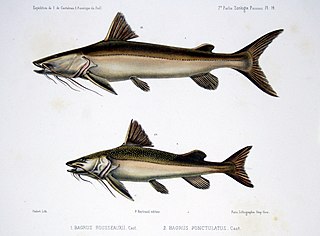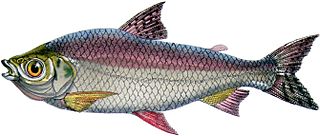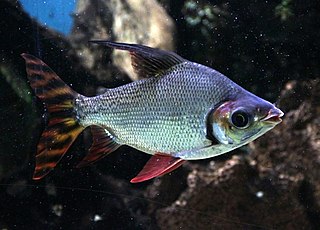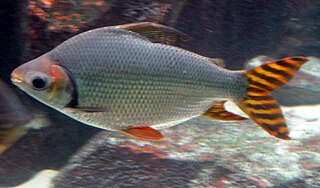
Tetraodontidae is a family of primarily marine and estuarine fish of the order Tetraodontiformes. The family includes many familiar species variously called pufferfish, puffers, balloonfish, blowfish, blowers, blowies, bubblefish, globefish, swellfish, toadfish, toadies, toadle, honey toads, sugar toads, and sea squab. They are morphologically similar to the closely related porcupinefish, which have large external spines. The scientific name refers to the four large teeth, fused into an upper and lower plate, which are used for crushing the hard shells of crustaceans and mollusks, their natural prey.

The Anostomidae are a family of ray-finned fishes that belong to the order Characiformes. Closely related to the Chilodontidae and formerly included with them, the Anostomidae contain about 150 described species. Commonly known as anostomids, they are found in freshwater habitats from the Río Atrato in northernmost South America to warm-temperate central Argentina; they are of Amazon origin, with few found west of the Andes. Their scientific name approximately means "mouth on top", from Ancient Greek áno- (ἄνω) "up" + stóma (στόμᾶ) "mouth", in reference to the arrangement of these fishes' mouth opening.

The eel-tailed catfish, Tandanus tandanus, is a species of catfish of the family Plotosidae. This fish is also known as dewfish, freshwater catfish, jewfish, and tandan.

The Curimatidae, toothless characins, are a family of freshwater fishes, of the order Characiformes. They originate from southern Costa Rica to northern Argentina. The family has around 105 species, many of them frequently exploited for human consumption. They are closely related to the Prochilodontidae.

The notchheaded marblefish is a species of marine ray finned fish, one of the marblefishes belonging to the family Aplodactylidae. It is found in the southwestern Pacific Ocean.

Brachyplatystoma is a genus of catfish from the family Pimelodidae. As the occasionally used common name goliath catfishes indicates, this genus includes some of the largest species of catfish, including the piraíba, B. filamentosum, which reaches up to the region of 3.6 metres (12 ft) in length. Brachyplatystoma are found in the Amazon and Orinoco basins, and other tropical freshwater and brackish habitats in South America. Some species are migratory. These fish are important as food fish and, to some extent, aquarium fish.

Epinephelus albomarginatus, the white-edged grouper, white-edged rockcod or captain fine, is a species of marine ray-finned fish, a grouper from the subfamily Epinephelinae which is part of the family Serranidae, which also includes the anthias and sea basses. It is found in the southwestern Indian Ocean and it is associated with coral reefs. It is a target species for commercial and recreational fisheries.
Nannostomus harrisoni,, is a species of pencil fish. Native to The Guianas, the species displays a single horizontal stripe of intense black, and blood red adornments on its fins. N. harrisoni is often confused with Nannostomus unifasciatus, another long, slender, single-striped species with similar profile and coloration, but N. harrisoni swims in a horizontal posture, as opposed to the snout-up oblique posture of N.unifasciatus, and the bright red adornments on the ventral fins of N. harrisoni are absent in N. unifasciatus. Though the recently described species N. grandis has been dubbed the largest member of the genus, adults of N. harrisoni commonly grow to a length of 70 mm, making it in fact the largest species of pencil fish described to date. It is commonly known as Harrison's pencilfish.

Prochilodus nigricans, or black prochilodus, is a species of prochilodontid fish from the Amazon Basin in South America. It supports major fisheries; according to IBAMA, it is the third most caught taxon in the Brazilian Amazon by weight, after Brachyplatystoma vaillantii and Semaprochilodus spp. The black prochilodus is migratory, moving between different parts of the Amazon. The black prochilodus reaches up to 45 cm (18 in) in total length and 1.2 kg (2.6 lb) in weight.

Orectolobus reticulatus, the network wobbegong, is a recently described species of carpet shark found in relatively shallow waters off Kimberley and Darwin in north-western Australia. With a known maximum length of only 52.3 centimetres (20.6 in), it may be the smallest species of wobbegong. Until its description in 2008, it had been confused with the northern wobbegong. The network wobbegong has a short snout, broad head, elongated body, and two dorsal fins, with the first being slightly larger than the second. Its body is grayish brown with darker brown markings and a pale yellow underbelly. The network wobbegong lives in shallow waters along reefy bottoms.

Prochilodus is a genus of freshwater fish from the family Prochilodontidae. This family include two other genera, Ichthyoelephas and Semaprochilodus, which have been included in Prochilodus instead. The greatest species richness of Prochilodus is in river basins in eastern, southeastern and southern Brazil, but there are also species in the river basins of the Amazon, Guianas, Colombia, Venezuela, Paraguay and northeastern Argentina. The largest species in the genus reach about 80 centimetres (2.6 ft) in length, but most species barely reach half that size.

Ichthyoelephas is a genus of South American freshwater fish from the family Prochilodontidae.

Semaprochilodus is a genus of South American freshwater fish in the family Prochilodontidae. They have sometimes been included in the genus Prochilodus instead. Of the six species, three are from the Amazon Basin, two from the Orinoco Basin and a single from the Maroni Basin. Depending on the exact species, they reach a maximum length of 27–54 centimetres (11–21 in).

Nannostomus espei,, commonly known as Espe's pencilfish or barred pencilfish, is a freshwater species of fish belonging to the characin family Lebiasinidae. It was first described in 1956 by Herman Meinken from the Mazaruni River system in Guyana and to date this is its only known location. It is notable amongst the genus in that the dominant body pattern consists of five broad, comma-like patches instead of the more normal horizontal stripes seen in the rest of the genus. This pattern of patches is assumed by other species at night, but only N. espei displays the pattern permanently and in daylight.

The kissing prochilodus or flag-tailed prochilodus is a species of South American freshwater fish in the family Prochilodontidae. It is native to central and western parts of the Amazon basin. It is migratory, moving in large groups into whitewater rivers to spawn, afterwards returning to blackwater and clearwater rivers, as well as flooded forests. It is important in fisheries and sometimes seen in the aquarium trade, but require a relatively large tank. It can reach a maximum standard length of 27.5 cm (10.8 in) and weight of 560 g (1.23 lb). It resembles the other members of the genus Semaprochilodus, where most species are silvery with orange-red fins and a striped tail. Adult S. insignis lack the dark flank spots that can be seen in adult S. taeniurus, but both species have these spots as juveniles.

Gobionotothen is a genus of marine ray-finned fishes belonging to the family Nototheniidae, the notothens or cod icefishes. They are native to the Southern Ocean.

The white sucker is a species of freshwater cypriniform fish inhabiting the upper Midwest and Northeast in North America, but it is also found as far south as Georgia and as far west as New Mexico. The fish is commonly known as a "sucker" due to its fleshy, papillose lips that suck up organic matter and aufwuchs from the bottom of rivers and streams.

The yellow Irish lord is a species of marine ray-finned fish belonging to the family Agonidae It is found in the northern Pacific Ocean.

A whitewater river is classified based on its chemistry, sediments and water colour. Whitewater rivers have high levels of suspended sediments, giving the water a pH that is near-neutral, a high electric conductivity and a pale muddy, café au lait-like colour. Whitewater rivers are of great ecological importance and are important to local fisheries. The major seasonal Amazonian floodplains known as várzea receive their water from them.
Copella nattereri or the spotted tetra is a species of fish in the splashing tetra family found in the upper Amazon basin, as well as the Rio Negro and Orinoco basins. They grow no more than a few centimeters.


















